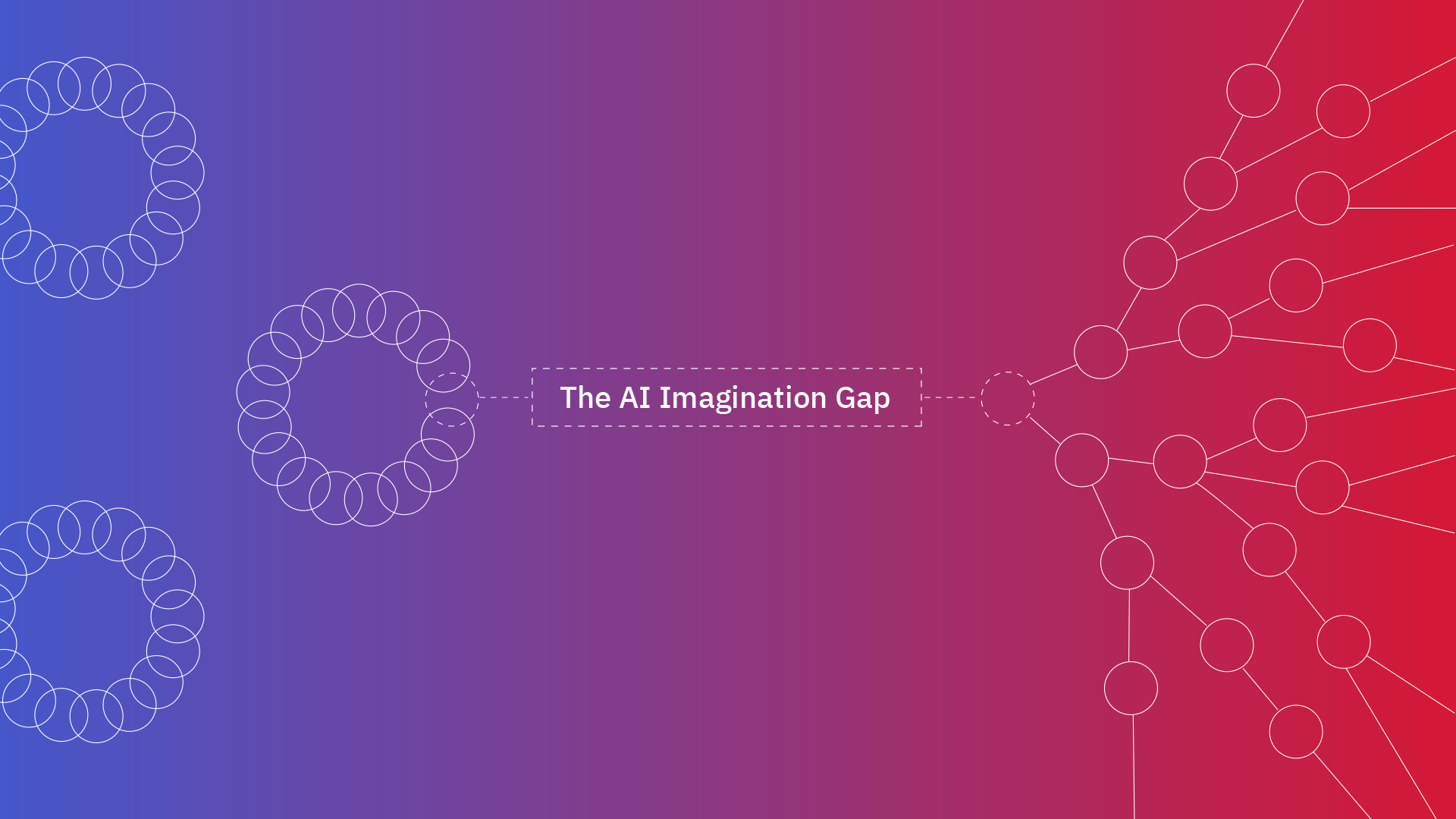
The seductive trap of incrementalism.
By now, we’ve all seen it: the app on our phone, where nothing significant has changed, except for the glorious new “✨AI button” in the bottom right corner. It’s clunky and doesn’t work particularly well, yet companies feel compelled to do it—a perfect metaphor for AI adoption efforts.
Most businesses pursuing digital transformation and AI adoption achieve only incremental results because they optimize for legacy business models and user experiences rather than reimagining possibilities. While they understand AI capabilities, they lack the vision to fundamentally reshape their operations and value propositions, failing to invest in their future possibilities.
On the other hand, growth-minded leaders know that they must deliberately disrupt themselves or risk being disrupted by external forces. They recognize a gap between what’s possible with AI right now and a future they can’t quite fully envision—a gap that requires more than technical expertise to bridge.
They are facing the Imagination Gap.
Organizations struggle to innovate because bridging the gap is challenging.
Internal constraints and institutional inertia make change difficult. Legacy processes, risk-averse cultures, and deeply embedded workflows often prioritize efficiency over exploration, making it hard to embrace new technologies and ways of working.

The common challenges leaders face:
- Historical knowledge trap: The tendency to rely too heavily on past experiences, successes, and established ways of working in decision-making criteria.
- Certainty bias:Favoring measurable and predictable outcomes over unknown possibilities, which can undervalue qualitative insights, emerging trends, and experimentation.
- Scarcity mindset: The belief system that views resources, opportunities, and successes as inherently limited, which results in defensive behaviors like hoarding resources or resisting change.
In stable times, these characteristics lead to predictable success. However, these are unusual times.
We are riding waves of change and it feels like everything is accelerating.
The great business promise of AI technology is that it changes the capabilities of value creation and lowers price points to deliver on that value. The feeling of urgency in companies with their adoption of AI is motivated by uncertainty of the future, increasing pressures to maintain profitability and, most importantly, a desire not to be disrupted by AI.
Change doesn’t happen overnight. One framework (that we like) to understand how organizations progress with AI adoption is the BOI three-wave model.

Credit to Board of Innovation (BOI), Illustration by Matt Fangman
- Wave 1: Efficiency: Businesses using AI to streamline operations
- Wave 2: Enhanced Quality: AI is improving processes
- Wave 3: System Transformation: Creating entirely new ways of doing things
Most companies remain stuck in Wave 1 because efficiency improvements offer comfortable, quantifiable wins. They implement AI to reduce headcount, automate repetitive tasks, or squeeze incremental savings from existing processes.
Moving to Wave 2 requires reexamining fundamental assumptions about quality and value delivery. The jump to Wave 3—where AI enables entirely new business models and value propositions—demands leadership commitment that few organizations cultivate.
We’ve seen financial services firms celebrate chatbots that answer basic customer queries (Wave 1) while missing opportunities to completely reimagine lending models through alternative data analysis (Wave 3).

The technology models are moving and improving fast. Businesses are trying to adopt that technology for the benefit of their customers. Organizations (the slowest to change) have to refactor to meet the new business and technology needs.
Despite all this accelerated change, it is important to remember that fundamental human needs remain the same.
Empathy is your competitive edge in an AI-powered world.
In the rush to implement algorithms and automate processes, we risk overlooking what hasn’t changed: fundamental human needs. We’ve observed well-engineered AI systems fail spectacularly because they ignored emotional context and relationship dynamics.
In one case, a healthcare system implemented AI diagnostics without considering how doctors would integrate these tools into patient conversations. They had perfected algorithmic recommendations but neglected the human touchpoints that built trust and loyalty.
The most significant AI implementation challenge isn’t technical—it’s human. Organizations move as fast as there is trust and shared understanding. Your engineers might build a functional AI solution in weeks, but organizational adoption takes months or years while people navigate shifting roles, new skills, and evolving team dynamics. The companies succeeding with AI aren’t just investing in algorithms—they’re investing in change management, skills development, and the psychological safety needed for their people to transform.
This can be addressed by incorporating human-centered mindsets, methodologies, and AI employee empowerment efforts into your workplace. With the evidence that employee engagement is at an all-time low, empowering and inspiring your human capital is at least as important as your technology capital.
Bridge the gap by embedding a future-thinking capability.
Proactively and boldly maintain agency over your organization’s future. Don’t get caught living inside legacy models and chasing someone else’s vision of the future.
Five steps you can take to bridge the AI imagination gap:
- Challenge Legacy Thinking: Identify and break free from the historical knowledge trap by questioning long-standing assumptions, processes, and success metrics. Encourage leaders to evaluate decisions through a future-focused lens rather than relying solely on past successes.
•
Practice suggestion: Run “assumption-breaking sessions” where your team can methodically question long-held business belief
• - Balance Data with Vision: Overcome certainty bias by integrating qualitative insights, emerging trends, and creative foresight into decision-making. Don’t just optimize for what’s measurable. Explore the possibilities and draft a vision.
•
Practice suggestion: Develop a strategic AI vision that is adaptive, actionable, and human-centered with responsible AI governance with an actionable roadmap for their organization’s future. Enhance ideation with future-thinking and practical implementation activities such as STEEP Analysis, Scenario Matrix, Horizon Radar, and Resilience Stress Testing for technology road mapping, comprehensive impact assessment, and risk mitigation.
•
- Adopt a Growth Mindset:Counteract scarcity thinking by viewing AI as an enabler of new value creation rather than just an efficiency tool. Shift from a defensive posture to one that sees AI as a catalyst for reinvention, experimentation, and expanded opportunities.
•
Practice suggestion: Move to offensive growth through mapping value spectrums, calculating opportunity costs, reimagining customer journeys, and exploring business model transformations.
•
- Prioritize Human-Centered AI: Remember that while technology evolves rapidly, human needs remain constant. Empathy, leadership, and user experience should be at the heart of AI adoption. Build systems that empower employees and enhance customer experiences, not just streamline processes.
•
Practice suggestion: Run simple workshops where teams observe actual users, identify pain points, and brainstorm AI solutions together. Create spaces where technical and business teams can quickly test ideas with real users before full implementation.
•
- Embed Future-Readiness as a Core Capability: Innovation isn’t a one-time initiative; it’s an ongoing practice. Develop internal mechanisms for continuous learning, adaptation, and bold experimentation to move beyond incremental change and toward true system transformation.
•
Practice suggestion: Create a 3-month rotating position where talented employees from different departments explore emerging AI applications, test concepts with customers, and present findings to leadership quarterly.
The future isn’t hiding in a feature update. Companies that chase the equivalent of the AI button will find themselves exactly where they started, but with only slightly better technology. The future belongs to the leaders who look at current business and market assumptions and say:
“These don’t have to be true anymore. Let’s imagine a new future.”
Written by Matt Fangman , Human-Centered Strategist (mattfangman.com), and Sean Wood, AI Business Transformation Strategist (humanpilots.ai/)
Article originally published on LinkedIn.
